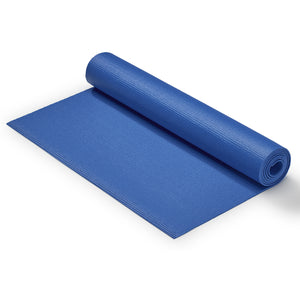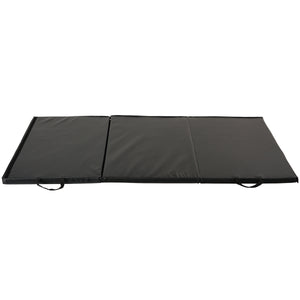A strong core is more than being able to do a lot of crunches or having a six pack. Real core strength means that you can use your core to help with everyday movements like flexion, extension, and rotation of the spine. However, it also means that you can remain stable and steady through your center and resist imposing outside forces (also known as anti-rotation).
If building core strength is one of your fitness goals, then it is essential to focus on your ability to twist, bend, and extend, as well as your ability to feel stable and grounded through your center. These 5 yoga poses will help you get there!
1. Boat (Navasana)

Begin seated with your knees bent and feet flat on the floor. Grab on to the back of your thighs and start to lift your feet off the mat as you keep your chest open and upright. You can keep your shins parallel with the floor or extend your knees and point your toes. Gently release your hands and extend them out in front of you.
Boat pose is one of the quintessential core building poses in yoga (you might have seen this called a v-sit in different types of workouts). You are targeting multiple muscles in your core at once (in your posterior AND anterior chain) while simultaneously working your balance.
For an additional challenge you can add in rotation at your core or extend your arms overhead while you focus on keeping your core stable and unmoving.
2. Balancing Table (Dandayamana Bharmanasana)

Begin in tabletop pose, with your hips stacked over your knees and shoulders stacked over your wrists. Start to engage your core by pulling your belly button back towards your spine and tucking your tailbone down. As you inhale, reach your arm forward out in front of you, as you reach your opposite leg behind you. Hold for 3-5 deep breaths.
Balancing Table is a great pose for building strength not only in your abdominal muscles but also in your back muscles and glutes (your core is more than just your abs!). It requires strength, stability, and balance so it’s a great posture for developing functional core strength.
To incorporate movement in this posture, bring your extended elbow to your opposite knee, and use your abdominal muscles to pull everything in to your center. As you inhale, extend your arm and leg back out into balancing table.
3. Extended Side Angle (Utthita Parshvakonasana)

Begin in Warrior II and start to shift your upper body forward. Rest your elbow on your knee and keep your chest open to the long edge of your mat. Reach your opposite arm towards the sky and then eventually overhead. Activate your core and squeeze your abdominal muscles as you start to lift your weight out of your elbow. From there, extend your bottom arm out in front of you as well, so your upper body is reaching forward towards the top of the mat.
This variation of extended side angle requires you to build core strength in a position that is outside of your normal movement pattern. It is important for your core to be strong through all different types of movement, not just flexion and extension – once you begin to approach core strength from all directions you will notice your strength jump to the next level!
4. Side Plank (Utthita Vasisthasana)

Begin in tabletop pose. Extend one leg back, then the other, for a high plank. Rotate and open to one side, rolling to the outer edges of your feet and reach one arm up towards the sky. Imagine you are in one straight line from the crown of your head down to your heels and stay lifted out of your shoulder joint.
To spice this pose up and add an extra challenge, lift your top leg as you squeeze your glute. Added balance and strength!
You have probably seen this pose outside of yoga class, as it is an excellent exercise for working your obliques. Bonus points for improving your shoulder stability too!
5. Revolved Chair Pose (Parivrtta Utkatasana)

Begin in Chair Pose – sit your hips back, bend your knees, and press through your heels. Extend your arms overhead as you tuck your tailbone down and close your ribcage. From there, bring your hands together in front of your chest. Start to twist from your center and hook your elbow on the outside of your opposite thigh. Keep your hips square and facing forward.
You can remain stationary in the twist or make this movement dynamic and move between the twist and neutral chair. This will help you build rotational strength through your core.
Better Than a Six Pack
Incorporating core strength exercises into your workout routine is a great way to focus on improving your functional capabilities and your ability to move through your day-to-day activities with ease. Good core strength will give you power for active hobbies, chores around the house, and other exercises in your workout routine. What’s not to love about that? Use your core as a way to feel centered and grounded, as well as a source of strength, movement, and power. Let your core elevate you to a whole new level of fitness!



























Add Your Name & Email
Please enter your name and email to continue.We won’t display your email publicly.
1 comment
Need work out for 76 year old
With 2 back surgery & left shoulder rotator cuff surgery, post op 1 year
I use sunny threadmill , 1 hour daily